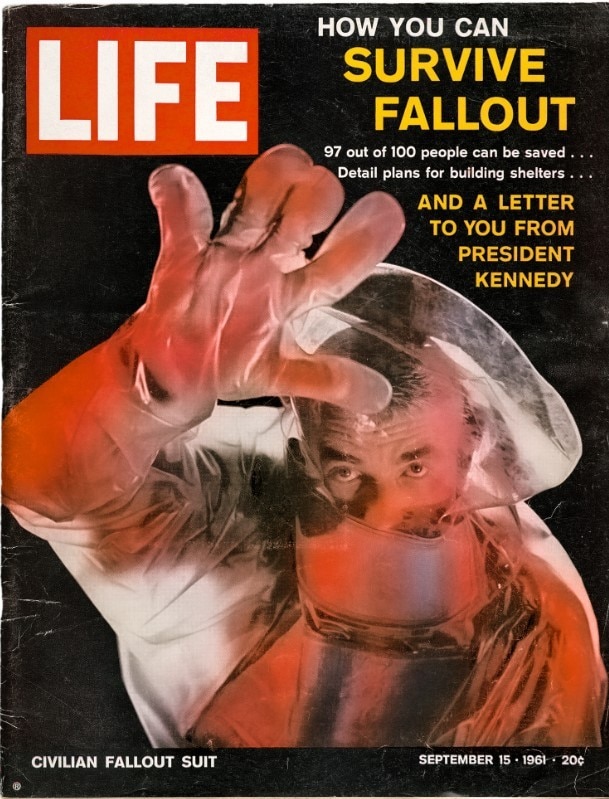The ancient history of the world is filled with prophecies and myths that act as recurring rituals, warning humanity of impending natural disasters: pandemics, eruptions, famines, earthquakes, floods. Yet, in these ongoing narratives, survival always finds a way. Preparing for such events isn’t just about worry; it’s a form of foresight, a design act in itself.
At the Design Museum of Lausanne, mudac – musée cantonal de design et d’arts appliqués contemporains – presents We Will Survive. The Prepper Movement, an exhibition exploring this mindset, which views reality as inherently fragile yet finds countless ways to navigate it, using strategies of survival.

This project was conceived by Anniina Koivu and was first previewed by mudac at Milano Design Week in 2023. It was then developed with Jolanthe Kugler, the museum’s new chief curator, into a major exhibition that delves deep into this often-hidden universe – examining the motivations, beliefs, and actions of preppers, along with objects, works, and spaces they create and inhabit.
The term “prepper” refers to various groups, from those adopting a self-sufficient lifestyle by retreating to remote areas, to activists embracing alternative ways of living, to the most extreme survivalists who approach everyday life with a paramilitary mindset.
The ancient history of the world is filled with prophecies and myths that act as recurring rituals, warning humanity of impending natural disasters: pandemics, eruptions, famines, earthquakes, floods.
While most people may not concern themselves with such matters, and simply hope nothing catastrophic happens, organized groups of preppers prepare for the worst. They live lives focused on controlling the uncontrollable. The idea behind prepping is not to be ready for the end, but for a new beginning.

The exhibition begins with a timeline presented in a long, narrow corridor lit by flashing lights. It traces humanity’s evolution through predictions, disasters, and key moments for the prepper movement.
It then divides into three themed sections, starting with Existential Threats and Risk Assessment, which identifies the primary threats to human existence today. Beyond natural disasters, stretching back to prehistory and mass extinctions, the exhibition also considers modern, human-made risks – terrorist attacks, biological threats, blackouts, nuclear warfare, and more. In our age, the sense of looming danger is palpable, from environmental disasters to health crises to geopolitical conflicts. An awareness of time becomes essential when living in a world of “mortals,” urging us to focus on what truly matters. The section is bookended by two symbolic clocks: the Doomsday Clock, created by the US Bulletin of Atomic Scientists in 1947, which serves as a metaphor for humanity’s proximity to global catastrophe, and Atelier Van Lieshout’s Back To The Future Clock (2019), which questions linear time and encourages us to rethink our priorities.

The heart of the exhibition is Individual Prepping. Set up like a supermarket with repurposed shelving, this section displays hundreds of everyday items – tools for dealing with emergencies across categories like water, food, heat, light, energy, shelter, hygiene, and communication. In this slightly unsettling space, visitors can also find tutorials on screens and leaflets offering practical advice: how to start a fire, identify edible plants in urban areas, tie knots, or make a toothbrush out of a twig.
In our age, the sense of looming danger is palpable, from environmental disasters to health crises to geopolitical conflicts. An awareness of time becomes essential when living in a world of ‘mortals,’ urging us to focus on what truly matters.
The final section, somewhat hidden like a back-office, focuses on Governmental Prepping, examining the steps nations have taken to protect their citizens – measures preppers often distrust, choosing instead to rely on their own methods. Five case studies highlight state-sponsored protection or evacuation plans.
The first is the United States, where, after the devastation of the atomic bombs and the onset of the Cold War, it became clear that global destruction was technically possible. In 1961, the government launched the Family Fallout Shelter plan, advising citizens on how to prepare for nuclear attacks

Tokyo, prone to earthquakes and tsunamis, is examined as a city of over 14 million people ready for almost any disaster. Naples is featured for the monitoring efforts of the Vesuvius Observatory, which has tracked the area’s volcanic activity since 1841, ensuring evacuation protocols are in place to protect 500,000 residents within 72 hours. Helsinki has an underground master plan, initiated during the Cold War and still expanding, providing the public with connected tunnels that house everything from sports facilities and museums to shelters. Switzerland, known for its exceptional preparedness, is highlighted for having more fallout shelters than citizens and for the National Redoubt, a network of armed fortresses built into the Alps.
Despite all the doomsday scenarios, the exhibition ends on a hopeful note, reminding us that our modern world is better in many ways than the past. Declines in infant mortality, improvements in education, reductions in pollution, and reforestation efforts are just a few of the hard-won gains pushing us toward a more sustainable future.

The message is clear: our planet is a living, changing entity. The question is whether we’ll wait for destructive change or embrace preparation and hope as the best tools for building a different, but better, future. After all, every end is a new beginning.
The exhibition design, by Swiss studio XPO (Camille Blin, Anthony Guex, and Christian Spiess), uses existing materials and a language of precariousness to reflect the theme of survival. Accompanying the exhibition is the book We Will Survive, published by mudac, offering historical and critical insights.
- Exhibition:
- We Will Survive. The Prepper Movement
- Location:
- Mudec, Lausanne, Switzerland
- Dates:
- From September 13th, 2024 to February 9th, 2025

Visual harmony and aesthetic
Now, more than ever, interior design is a balance of form and function, a dialogue between architecture, materials and finishes that transform and make the most of the space involved.









